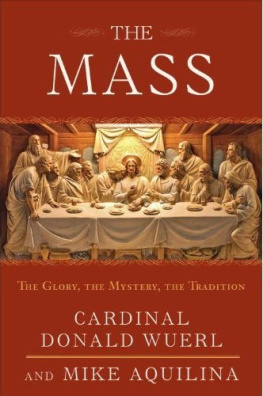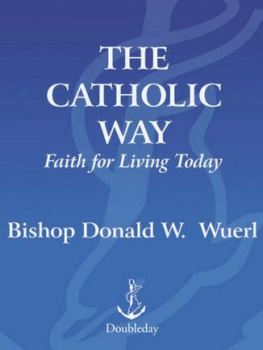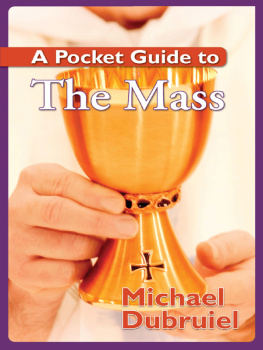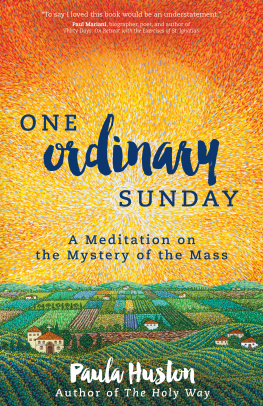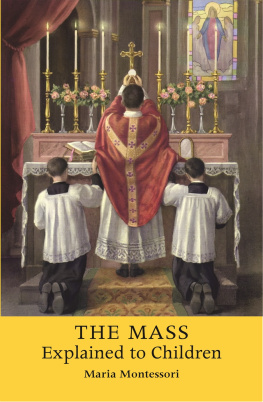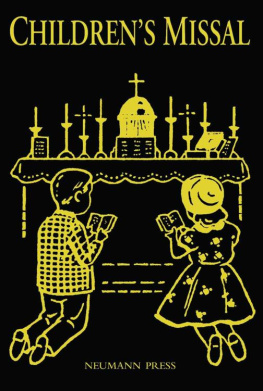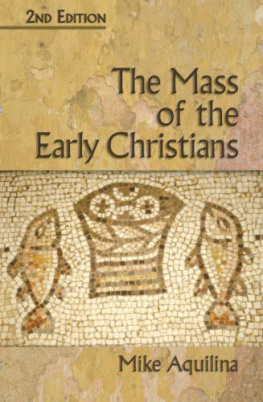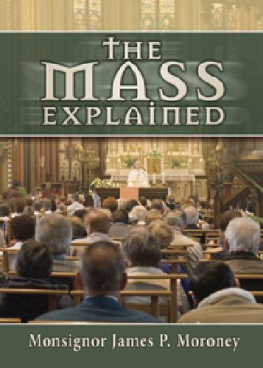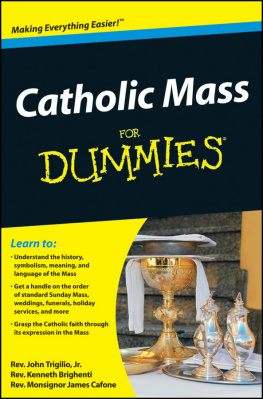THE MASS
The Glory, the Mystery, the Tradition
CardinalDonald Wuerl and Mike Aquilina
Foreword by Archbishop J.Augustine Di Noia , O.P ., Secretary of theCongregation for Divine Worship and the Discipline of the Sacraments
Preface by Cardinal Francis George, O .M.I ., Archbishop of Chicago

NEW YORK LONDON TORONTO SYDNEY AUCKLAND
Copyright 2011by Donald Wuerl and Michael Aquilina
All rightsreserved.
Publishedin the United States by Doubleday Religion, an imprint of the Crown PublishingGroup, a division of Random House, Inc., New York. www.crownpublishing.com
www.doubledayreligion.com
Doubleday and theDD colophon are registered trademarks of Random House, Inc.
Library ofCongress Cataloging-in-Publication Data is available upon request.
ISBN978-0-307-71880-8
Book design byEllen Cipriano
Jacket photograph:Michael Hoyt
CONTENTS
A Note from the Authors
Before we began writing this booktogether, we had known each other for many years. We haveprayed together, worked together, and shared the same Eucharistic table butwith a difference. One of us approached the altar as a priest-celebrant;the other as a lay Catholic, husband, and father. In the pages of this book, wetry to present both of those perspectives on the Mass, so that readers mightexperience a "panoramic" view of the central act of Christianworshipan action instituted by Jesus Christ and entrusted to his Church.
We took to writing this bookbecause we share an ardent love for the Mass. We have written much about theMass down through the years, and spoken often on the subject, and some of thatmaterial has found its way into these pages.
For both of us, the Mass is thefoundation and center of every day's activity. We want to encourage that sameappreciation in those in the Church, in the neighborhood, and in the home whoshare our faith.
The book arose, then, out of ourcommon interest and common devotion, and our desire to make that interest anddevotion much more common than it is today. When we say "common,"however, we don't mean "low" or "pedestrian." We mean"ordinary." We pray that this book might in some small way helpreaders to make the Mass a more regular and even necessary part of their days.We hope they, in turn, will share their renewed fervor with others.
Our immediate occasion for takingon such a large project was the approval by the United States bishops, incollaboration with the English-speaking bishops around the world, of a newtranslation of the Roman Missal. We believe this is a key part of the NewEvangelization called for by our Holy Father, Pope Benedict XVI. He used theword "re-propose" to describe the New Evangelization. We need tore-propose our belief in Christ and his Gospel for the sake of those who areconvinced that they "already know" the faith and that it offersnothing interesting. We want to invite them to hear it all over again, as iffor the first time.
We pray that our book will be useful to believers asthey speak and hear new words of worship and praise, in a rite that is, likethe Gospel, ever ancient and ever new.
Foreword
ByArchbishop J. Augustine Di Noia , O.P ., Secretary of the Congregation for DivineWorship and the Discipline of the Sacraments
The authors begin this book with aphrase that is simple and seemingly self-evident: "The Mass is whatCatholics do." By frequently citing the earliest Christian witnessestheScriptures and the Church fathersthe authors go on to demonstrate that theMass is what Catholics have always done.
The Mass is present always andeverywhere. It's simply what Catholics do, as long as we have life's breath.Indeed, we can say that it's like breathing. It keeps us spiritually alive.It's a sign that we are still living the life God has given us, in the way God has made us to live it.
Breathing is constant,commonplace. We breathe without thinking about itunless it's impeded for somereason. It's simply what we do. Yet biologists tell us it is anything butsimple. Every breath is a rich and complex event that affects all our bodilysystems, right down to our constituent chemistry.
The Mass, too, is constant andcommonplace. Yet it is also rich and complex. Every word and gesture has ahistory, a significance , a meaning.
This is the way God makes things.Even the simplest and most elemental events signify processes that are vital,essential, and beautiful, if examined.
What is commonplace we tend totreat as unimportant. We treat such events the way we do respiration, assomething done unthinkingly. We go through the motions.
We must not allow this to happento the Mass. Yet too often we do. Thus, as long as the Church has celebratedthe Mass, its teachers have done what the authors of this book have done. Theyhave explained or unveiled the signs and mysteries of the Mass. The fathers ofthe ancient Church even had a word for this type of preaching. They called it,in Greek, mystagogia guidance through themysteries. It is also called "liturgical catechesis." Its aim,according to the Church's Catechism, is "to initiate people into themystery of Christ ... by proceeding from the visible to the invisible, from thesign to the thing signified, from the 'sacraments' to the 'mysteries'"(Catechism of the Catholic Church [ CCC ] n. 1075).
We find this " mystagogical " approach best exemplified in the worksof the giants of the early Church: Saint Cyril of Jerusalem, Saint Ambrose ofMilan, Saint John Chrysostom, and Saint Augustine. We find it in the NewTestament as well, in Saint John's Gospel, in the Letter to the Hebrews, and inthe First Letter of Saint Peter.
As long as the sacraments havebeen "what Catholics do," the Church's teachers have taught about thesacraments in this way.
In the year 2007 Pope Benedict XVIcalled for a renewal of such teaching. He was himself responding to therequests of a synod of bishops that had gathered in Rome to discuss theEucharist. (The cardinal-coauthor of this book was an active participant in thatsynod.) The synod fathers "asked that the faithful be helped to make theirinterior dispositions correspond to their gestures and words." Otherwise,the Holy Father indicated, they could risk falling into "ritualism,"which is really a sort of superstition. He called for "an education inEucharistic faith capable of enabling the faithful to live personally what theycelebrate."
This book is an answer to that call. It is unusualbecause it is truly a collaboration between a prelate and a laymantwo men whohave experienced the Mass daily, for decades, but from different sides of thesanctuary. Thus the authors are able to present the view from the pew and theview from the altar, and to draw them together as the view of the whole Church,both laity and clergy. Cardinal Wuerl and Mike Aquilina are able to articulate the questions that arise inthe minds of worshippers, and answer them in an engaging and accurate way. Theyfollow closely the method Pope Benedict outlined for mystagogical teaching in his apostolic exhortation Sacramentum Caritatis . The Holy Father's outline isworth quoting at length:
a. It interprets the rites in the light ofthe events of our salvation, in accordance with the Church's living tradition. Thecelebration of the Eucharist, in its infinite richness, makes constantreference to salvation history. In Christ crucified and risen, we trulycelebrate the one who has united all things in himself (cf. Ephesians 1:10).From the beginning, the Christian community has interpreted the events ofJesus' life, and the Paschal Mystery in particular, in relation to the entirehistory of the Old Testament.
b. A mystagogical catechesismust also be concerned with presenting the meaning of the signs containedin the rites. This is particularly important in a highly technological age likeour own, which risks losing the ability to appreciate signs and symbols. Morethan simply conveying information, a mystagogical catechesis should be capable of making the faithful more sensitive to thelanguage of signs and gestures which, together with the word, make up the rite.
Next page
